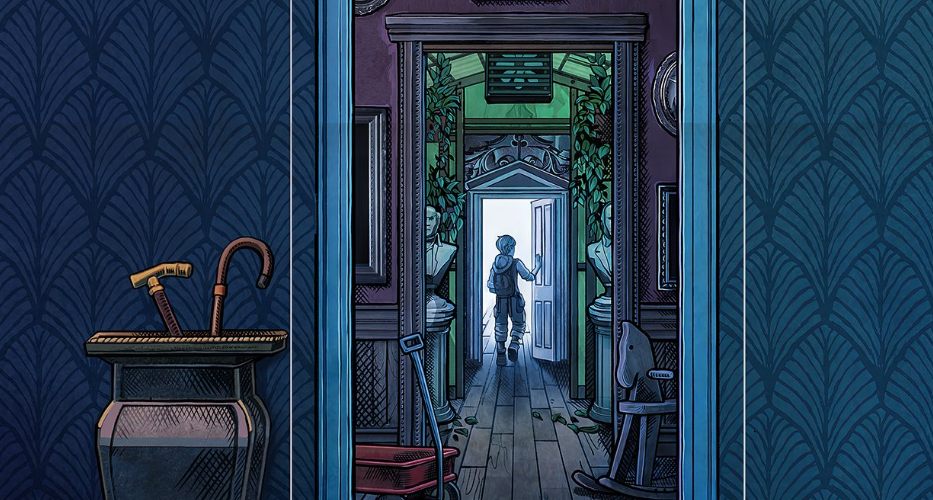If you’re like Kainenchen and me, you’ve been utterly obsessed with Blue Prince for the last month or more. Now, a roguelike puzzle game isn’t necessarily for everyone, but the lessons the game has to offer are for everyone with even a passing interest in dungeon design. This list is not exhaustive. You can help Harbinger of Doom by expanding it.
If you’re thinking about letting me know in the comments how you hate puzzles and think puzzles don’t ever belong in games, that’s fine, but with all the love in the world, we can probably just not, today.
This post may contain spoilers for Blue Prince. You have been warned.
Now, it’s a puzzle game, so unsurprisingly a lot of its lessons are about how it presents puzzles.
Puzzles Don’t Need to Be Hard
Especially in the early game, you run easy, straightforward puzzles. There’s a math puzzle in the Billiard Room (where learning the rules is part of the challenge) and a logic puzzle in the Parlor (where the game explains the rules in detail). Basic room drafting is also a form of puzzle, but “failing” at drafting just means you Call It a Day—which you’re going to do a whole lot, no matter what.
The Billiard Room and Parlor puzzles escalate slowly in difficulty. It’s honestly impressive that they’ve created a puzzle structure that can get reused as many times as those are. (The math puzzles do turn obnoxious, but you’ve drafted the room a good 30-40 times by then.)
Other puzzles, like the Utility Room’s VAC system, you can’t reasonably solve at all without finding the how-to. In case you’re stumped on that one, well, there’s a how-to that is a payoff for investigation in the game. In contrast to the Billiard Room and Parlor puzzles, you only need to solve that puzzle once. The challenge of it, other than finding the how-to, is following the instructions correctly.
Mora Jai puzzles are another recurring puzzle model. Each one has a different recombination of the same set of rules, based on tile color. You never have to solve them to move forward in the game; you just solve them to get the Allowance Tokens within. They’re right at the upper limit of my tolerance for frustration when I’m playing late at night, often because if I don’t solve the puzzle now, it’ll be hard to get back to.
You can kind of break puzzle difficulty down into what’s hard about them:
- Is it hard to understand how to interact in the first place? (This often shows up in games as pixel-bitching, like puzzles to get your cursor over the tiny button for the secret door.)
- Is it hard to understand what your interaction will do?
- Is it hard to understand what outcome represents a solution? That is, what you’re even trying to do?
- Is there a probable soft-failure condition? (As in, you start over.)
- Is there a probable hard-failure condition? (Many puzzles don’t have these, beyond possibly a timer; the Parlor puzzle is one of the few Blue Prince puzzles with a likely hard failure.)
- Is the minimum number of steps to get from the start to the solution large?
You don’t need your puzzle to say yes to more than 1-2 of these. In 99% of all game uses, and especially in dungeon design, you have no interest whatsoever in a failure outcome. Your game design goal is to intensify the sense of emotional reward from success: “I solved the puzzle and felt amazing about it.”
A Puzzle Solution Can Be a Great Reward
There are times in Blue Prince where the solution to a puzzle appears in full in a different location. The game is rewarding exploration with backstopping your puzzle-solving: if you’ve struggled with that particular puzzle, now you can just write down the answer. (Blue Prince is drawing a lot of notice for being a game that wants you to take notes.) As a result, exploring in one place can open up a reward or new exploration opportunities in a different area. The guide to the Pump Room in the Library is a great example of this, as are several of the books you can buy from the Bookshop. Similarly, the game eventually just tells you to combine a Power Source room with the Pump Room and the Laboratory. Doing that opens up all kinds of stuff.
For other games, if you establish a more complicated puzzle, especially if you know the players are now stuck on it, find other places in the game to place clues or whole solutions. Emotionally, this replaces the puzzle-solving moment with a moment of recognition. The moment of recognition is still solving a puzzle by engaging our pattern-matching brains, and exploration leading to reward is well-trod ground. I won’t try to improve on what Ursula K. le Guin had to say about it.
Puzzles Provide Extra Stuff
Puzzles don’t block your progress. Other than the fact that the core game loop is also a kind of puzzle and you can run out of steps or places to go in that core loop, you don’t have to solve a puzzle to make basic progress in Blue Prince. In a dungeon design, this means “there are always other paths forward that you don’t have to solve a puzzle to open.” Those alternate paths forward are a pressure valve for player frustration.
This is the same rule and for essentially the same reason as not locking plot-critical information or other forward progress behind a mandatory skill check. You want players to have an easier time because of their hard work (solving puzzles) or good luck (dice roll), avoiding encounters or gaining extra treasure. Murphy’s Number Theory: if the dice can ruin a plot, they will ruin a plot.
Preview of the Coming Attractions
There are several times in the game where you can see something really interesting that you can’t do anything about yet, like looking out the Clock Tower window. If the window points the right way (I don’t know for sure that it can point other ways, I’m just guessing), you can see the Rogue Moon that marks Room 46, standing above the rest of the mansion’s roof. In the reservoir, you can see interesting things you can’t reach until you solve the Pump Room puzzle with a Power Source room, which might take a lot of doing.
The point here is that you can build anticipation with visual description with windows (some of which may need to resist breaking or block teleportation, depending on the party’s level), chasms too wide to cross, visions in reflecting pools, and so on. Even getting a really cool key a long time before you can use it is a promise of cool things to come. (Blue Prince has a lot of cool Major Keys, and you’re often sitting on those for a long time before you find their door.)
Persistent Changes
Blue Prince is a roguelite game, which means you’re wiping the slate clean and restarting a lot. But the other thing about roguelites is that you do make some permanent changes and upgrades, run over run, so that you can accomplish more. Those changes include blessings that last a certain number of days, Allowance Tokens for extra money, stars that grant improved benefits as you have more of them, new rooms you can draft, altered room rarity, and—maybe most transformative—new pathways that permanently open up.
I wrote about this idea more than eleven years ago in this blog, but I still think it’s an underexplored design space: intentional ways for players to make permanent, beneficial changes in a dungeon, often through restoring original intended functions. That could be anything from “every day at dawn, this room produces a 100gp gemstone that you can harvest” to “this room improves your weapons’ bonuses to attack and damage to +2 for 8 hours.”
There’s a more complicated point that I want to make about pushing setting characterization in everything that happens—this is how you establish the stakes and meaning of the late-game conflicts—but honestly I need another whole post to explore that and all the ways Blue Prince does it. Until then, I hope you’ve enjoyed this post, I hope you’re enjoying Blue Prince (I have so much sympathy for folks who get motion sickness from it and can’t), and I hope you can get the battery, the broken lever, the sledgehammer, and the Workshop all in the same run. Maybe with the aid of Coat Check.

